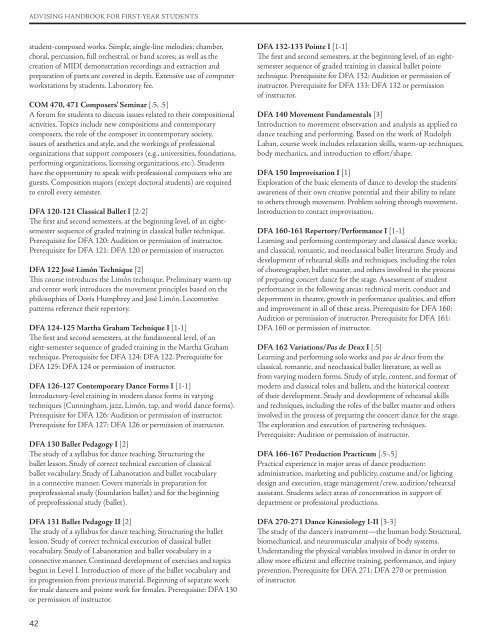advising
You also want an ePaper? Increase the reach of your titles
YUMPU automatically turns print PDFs into web optimized ePapers that Google loves.
ADVISING HANDBOOK FOR FIRST-YEAR STUDENTS<br />
student-composed works. Simple, single-line melodies; chamber,<br />
choral, percussion, full orchestral, or band scores; as well as the<br />
creation of MIDI demonstration recordings and extraction and<br />
preparation of parts are covered in depth. Extensive use of computer<br />
workstations by students. Laboratory fee.<br />
COM 470, 471 Composers’ Seminar [.5, .5]<br />
A forum for students to discuss issues related to their compo sitional<br />
activities. Topics include new compositions and contemporary<br />
composers, the role of the composer in contemporary society,<br />
issues of aesthetics and style, and the workings of professional<br />
organizations that support composers (e.g., universities, foundations,<br />
performing organizations, licensing organizations, etc.). Students<br />
have the opportunity to speak with professional composers who are<br />
guests. Composition majors (except doctoral students) are required<br />
to enroll every semester.<br />
DFA 120-121 Classical Ballet I [2-2]<br />
The first and second semesters, at the beginning level, of an eightsemester<br />
sequence of graded training in classical ballet technique.<br />
Prerequisite for DFA 120: Audition or permission of instructor.<br />
Prerequisite for DFA 121: DFA 120 or permission of instructor.<br />
DFA 122 José Limón Technique [2]<br />
This course introduces the Limón technique. Preliminary warm-up<br />
and center work introduces the movement principles based on the<br />
philosophies of Doris Humphrey and José Limón. Locomotive<br />
patterns reference their repertory.<br />
DFA 124-125 Martha Graham Technique I [1-1]<br />
The first and second semesters, at the fundamental level, of an<br />
eight-semester sequence of graded training in the Martha Graham<br />
technique. Prerequisite for DFA 124: DFA 122. Prerequisite for<br />
DFA 125: DFA 124 or permission of instructor.<br />
DFA 126-127 Contemporary Dance Forms I [1-1]<br />
Introductory-level training in modern dance forms in varying<br />
techniques (Cunningham, jazz, Limón, tap, and world dance forms).<br />
Prerequisite for DFA 126: Audition or permission of instructor.<br />
Prerequisite for DFA 127: DFA 126 or permission of instructor.<br />
DFA 130 Ballet Pedagogy I [2]<br />
The study of a syllabus for dance teaching. Structuring the<br />
ballet lesson. Study of correct technical execution of classical<br />
ballet vocabulary. Study of Labanotation and ballet vocabulary<br />
in a connective manner. Covers materials in preparation for<br />
preprofessional study (foundation ballet) and for the beginning<br />
of preprofessional study (ballet).<br />
DFA 131 Ballet Pedagogy II [2]<br />
The study of a syllabus for dance teaching. Structuring the ballet<br />
lesson. Study of correct technical execution of classical ballet<br />
vocabulary. Study of Labanotation and ballet vocabulary in a<br />
connective manner. Continued development of exercises and topics<br />
begun in Level I. Introduction of more of the ballet vocabulary and<br />
its progression from previous material. Beginning of separate work<br />
for male dancers and pointe work for females. Prerequisite: DFA 130<br />
or permission of instructor.<br />
DFA 132-133 Pointe I [1-1]<br />
The first and second semesters, at the beginning level, of an eightsemester<br />
sequence of graded training in classical ballet pointe<br />
technique. Prerequisite for DFA 132: Audition or permission of<br />
instructor. Prerequisite for DFA 133: DFA 132 or permission<br />
of instructor.<br />
DFA 140 Movement Fundamentals [3]<br />
Introduction to movement observation and analysis as applied to<br />
dance teaching and performing. Based on the work of Rudolph<br />
Laban, course work includes relaxation skills, warm-up techniques,<br />
body mechanics, and introduction to effort/shape.<br />
DFA 150 Improvisation I [1]<br />
Exploration of the basic elements of dance to develop the students’<br />
awareness of their own creative potential and their ability to relate<br />
to others through movement. Problem solving through movement.<br />
Introduction to contact improvisation.<br />
DFA 160-161 Repertory/Performance I [1-1]<br />
Learning and performing contemporary and classical dance works;<br />
and classical, romantic, and neoclassical ballet literature. Study and<br />
development of rehearsal skills and techniques, including the roles<br />
of choreographer, ballet master, and others involved in the process<br />
of preparing concert dance for the stage. Assessment of student<br />
performance in the following areas: technical merit, conduct and<br />
deportment in theatre, growth in performance qualities, and effort<br />
and improvement in all of these areas. Prerequisite for DFA 160:<br />
Audition or permission of instructor. Prerequisite for DFA 161:<br />
DFA 160 or permission of instructor.<br />
DFA 162 Variations/Pas de Deux I [.5]<br />
Learning and performing solo works and pas de deux from the<br />
classical, romantic, and neoclassical ballet literature, as well as<br />
from varying modern forms. Study of style, content, and format of<br />
modern and classical roles and ballets, and the historical context<br />
of their development. Study and development of rehearsal skills<br />
and techniques, including the roles of the ballet master and others<br />
involved in the process of preparing the concert dance for the stage.<br />
The exploration and execution of partnering techniques.<br />
Prerequisite: Audition or permission of instructor.<br />
DFA 166-167 Production Practicum [.5-.5]<br />
Practical experience in major areas of dance production:<br />
administration, marketing and publicity, costume and/or lighting<br />
design and execution, stage management/crew, audition/rehearsal<br />
assistant. Students select areas of concentration in support of<br />
department or professional productions.<br />
DFA 270-271 Dance Kinesiology I-II [3-3]<br />
The study of the dancer’s instrument—the human body. Structural,<br />
biomechanical, and neuromuscular analysis of body systems.<br />
Understanding the physical variables involved in dance in order to<br />
allow more efficient and effective training, performance, and injury<br />
prevention. Prerequisite for DFA 271: DFA 270 or permission<br />
of instructor.<br />
42



